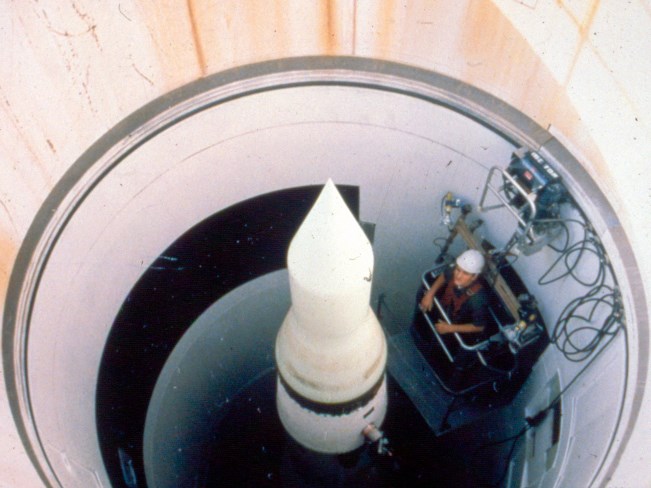Part of a series of articles titled A Cold War Cast Of Thousands.
Previous: Female Missileers
Article

Ellsworth Air Force Base
Although maintenance crews did not serve regular alert tours at the Launch Control Facilities, they routinely entered the control centers and silo sites to perform inspections, conduct routine upgrades, or make necessary repairs. The maintenance force was responsible for ensuring that all systems were operable and on ready status by following precise technical orders written by Air Force engineers. The rank of the maintenance crew varied depending on the experience and responsibilities of the team, and could range from Airman up to Captain.
Each Minuteman wing included a deputy commander for maintenance who operated the base maintenance complex and was responsible for planning, scheduling, and directing all maintenance of LCF and LFs in their wing. Air Force maintenance included four divisions and two squadrons. The Field Missile Maintenance Squadrons (FMMS) and the Organizational Missile Maintenance Squadrons (OMMS) were responsible for the actual maintenance of the Minuteman missiles and support equipment. The FMMS maintained hydraulic and pneumatic systems, site support equipment, and test equipment. This squadron also performed periodic maintenance at the sites. The OMMS had a mechanical and electrical branch that were responsible for the transportation, installation, and removal of missiles, the reentry vehicles and systems, propulsion system rocket engines, and the emergency rocket communications systems. The OMMS also repaired electrical, surveillance, and access systems. Despite routine maintenance and inspections at the LFs, the deputy commander for maintenance routinely received notification of equipment faults at LFs and LCFs directly from the missileers in the LCC.
A maintenance team chief, responsible for supervising the crew, attended every maintenance call. Even with the presence of a security alert team on all maintenance missions, the maintenance team chief was responsible for authenticating their access with the missile commander in the Launch Control Center (LCC). The team chief was accountable for all activities at the site while they were performing maintenance duties. As of 1963 maintenance teams at Launch Facility sites were required to be in contact with the LCF a minimum of every thirty minutes.
Maintenance crews transported their equipment in "U-vans" or utility vans. This van was a three-quarter-ton pickup with a utility box on the back. The utility box had several different compartments that organized the equipment and tools needed to make repairs at the Launch Facilities or LCFs. Work on a Launch Facility frequently required access to underground facilities. To do this the maintenance crew had to pass through "formidable mechanical barriers" in a process that sometimes took up to an hour.
First the security pit weather cover was removed, a combination was entered, and the security pit vault door was removed. These security procedures allowed retraction of the locking shaft and operation of the controls for the pump and two hydraulic cylinders used to slowly raise the steel and concrete primary door (personnel access hatch). After securing a metal ladder, the crew descended a few feet down the cylindrical shaft and entered another combination into the secondary door (B-plug) and retracted the locking bolts. After a preset timed interval, the large steel plug would lower to the level of theupper equipment room. The crews could then climb down the equipment room surrounding the launch tube, lower their equipment, and begin their maintenance tasks. Two shotguns, ammunition, and gas masks were placed in each silo in 1978 to increase security at the site.
Maintenance crews were only permitted to be in the field a total of sixteen hours on a dispatch to ensure a level of alertness. After completing pre-maintenance tasks, including vehicle and equipment checks and briefings, the team drove to the site, went through the authentication process, and began accessing the underground missile. Since the sixteen hours must include time to return to Ellsworth Air Force Base and go through the pre-maintenance tasks in reverse order, a maintenance team may only have five hours to perform maintenance at the Launch Facility. Due to the distance of many of the missile silos from Ellsworth Air Force Base, maintenance crews often remained at the closest LCF on Remain Overnights (RONs).
Although maintenance was usually routine, crews sometimes faced unexpected circumstances. In one unusual incident in 1975, for example, a maintenance crew was dispatched to a Minuteman LCC at Minot Air Force Base in North Dakota to help free four trapped missile crewmen. The incident occurred when two missile crewmembers arrived at the LCC to relieve the crew on duty. They entered the LCC and proceeded through the changeover process, only to discover that the blast door would not open. Maintenance responded to the call of the missile commander for assistance, but the blast doors were designed to resist force from the outside. Through a small hole, maintenance passed technical instructions to the four crew members to dismantle panels from the door. It took eight hours to remove the necessary panels and to dislodge the first of four three- inch pins. Several hours later only one pin remained in place, but it would not budge. A special welding team arrived at the site, and spent an additional four hours cutting through the door. After thirty-and forty-two-hour alert tours, respectively, the two crews were finally free to exit through the twelve-foot by twelve-foot hole.
Part of a series of articles titled A Cold War Cast Of Thousands.
Previous: Female Missileers
Last updated: October 20, 2020